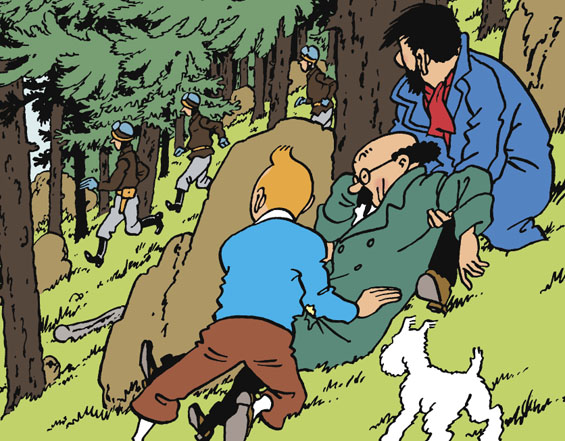Cold War ?

Since the recent events involving Georgia and the strained relations between the United States and Russia, journalists have been talking about a "return to the cold war." Question: what is a cold war? And what's the difference between a "cold" war and a "hot" one?
Tintin and the "cold" war
A "cold war" is one in which the protagonists don’t confront each other fully armed. The world witnessed a cold war from 1946 until the early 1990’s, when two political systems faced off, communism, represented by the Soviet Union and its satellite countries such as Poland, Bulgaria and Cuba, and so-called capitalist countries, led by the United States. In fact, a similar “cold war” situation was perfectly represented in two of Hergé’s books: The Calculus Affair and Tintin and the Picaros. In The Calculus Affair we see the forces of Syldavia and Borduria in unarmed conflict. Syldavia is a symbol of the capitalist system, whereas Borduria represents a dictatorship ruled with a rod of iron by Marshal Kûrvi-Tasch, who has a moustache reminiscent of Joseph Stalin, leader of the Soviet Union from 1927 until his death on March 5, 1953.
Origins of the cold war
On 5th March 1946, Winston Churchill, former British prime minister, invented the expression "cold war" during a conference in the United States. He was referring to the dangers posed by competition between the West and the Soviet Union, which could bring about a widespread nuclear war. In fact, Churchill had a deep-seated distrust of Soviet power. This led him to say, upon the death of Adolf Hitler, the German dictator (April 30, 1945), that the allied forces had mistaken their enemy, meaning that Stalin was the true danger to the West. The cold war had the advantage of avoiding direct conflict between the super powers which remained at the end of World War II: the USSR and the US. But these two great powers continued to oppose each other in various areas. The Vietnam War was a direct product of the cold war, as were the bloody battles that ripped through Africa, Asia and Latin America.
Twentieth century confusion
During the night of October 26 and 27th, 1917, power in Russia passed to the communists. On October 29, 1922 Mussolini took charge of the Italian government. On January 30, 1933 Hitler became the German chancellor. What’s the connection between these three dates and places? All three events were described as socialist ones. For example, the official name of Hitler’s party was the "national socialist party of German workers", and they formed a powerful force, even though Mussolini and Hitler claimed to be fighting communism – as were a number of democratic states in Europe. This explains the confusion in the minds of Europeans leading up to World War II. The two greatest enemies of the communist system were the United States and Great Britain, but they both aligned with the Soviet Union to combat Hitler and Mussolini, enemies of the USSR. It was enough to confuse anyone!
Dividing the world
In October 1944, the Soviet leader, Stalin, and the British prime minister, Churchill decided the fate of the Balkan state, which, except for Greece, passed to communist control. The current turmoil in Serbia, Kosovo and Montenegro are partly a result of that agreement. From February 4 to 11, 1945, Americans, Soviets and British representatives met at Yalta, on the Black Sea, to discuss the results of the war and to divide up the world. In Potsdam (Germany) on July 17 of that year they divided Germany into four zones of influence. At about the same time, June 26, 1945, the United Nations was founded in San Francisco, later to be headquartered in New York. This institution was supposed to guarantee peace between the nations that existed after the war. This was not to be the case!
A balance of terror
It soon became apparent that yesterday’s allies, who defeated Germany and Japan, had opposing interests. Stalin managed to overturn all the democratic governments in the countries of Eastern Europe, and also had his eye on the rest of Europe. From August 6, 1945, it was known that the United States had the atomic bomb, the “absolute weapon” of the era. The Soviets followed suit in September 1949. In a very short time both these countries had the power to destroy the world several times over. That is how the "balance of terror" came to be, threats and defiance were OK, but all-out atomic war was not waged. To stem the Soviet’s territorial appetite, the United States and Western Europe founded the North Atlantic Treaty Organization (NATO), a military treaty alliance (1949). The Soviet’s sponsored the Warsaw Pact in 1955, in response to the creation of NATO./p>
Some important cold war dates
October 1949: the Soviet occupied zone in Germany becomes a republic. Berlin, divided into four zones, is in the middle of the new state, creating constant tensions. July 1953: end of the Korean conflict, which leaves that country divided into two states, one communist and the other capitalist. October 1962: missiles with atomic warheads are installed by the Soviets in Cuba, a few miles from the United States. After threats by President Kennedy, the missiles are dismantled. There is not enough space to list all the conflicts of the era, which were "cold" only for the Unites States, Europe and the USSR. There were countless fatalities during that time… It wasn’t until December 21, 1991, with the dissolution of the Soviet Union, that cold war ended. But will it be the last one?




 News
News Forums
Forums E-books
E-books

